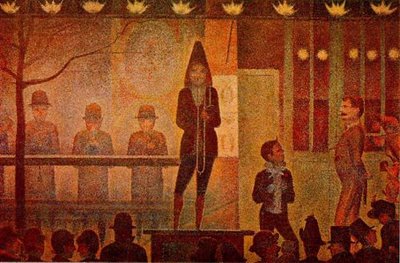 Robert Bresson (1901-1999) - Pickpocket, 1959
Robert Bresson (1901-1999) - Pickpocket, 1959
"There is a prominent credit at the start of Pickpocket to the mysteriously named Kassagi, who is not only part of the cast as ‘Accomplice 1’ but, even more importantly, ‘Technical Adviser for the Thieves' Gestures’. And what gestures they are! Nimble fingers that steal into breast pockets, a hand that drops a wallet in a split-second beat down to another hand (his own or someone else's), swift movements that transfer an object from a newspaper to a bag to a coat...
Robert Bresson may well have found Kassagi in the criminal underworld. Cinematographer Leonce-Henry Burel tells the story of a day on set when, due to complex outdoor filming, several gendarmes were present to supervise crowds and traffic. At the end of the day, Kassagi took these cops to the pub - where he revealed to them every key, wallet and watch he had surreptitiously stolen from them while they worked. After the film wrapped, Kassagi was too well known to return to a life of crime. Instead, he started on a successful career as a music hall and cabaret entertainer. His magic skill of prestidigitation moved from streets and train stations to the showbiz stage.
Pickpocket is all about the transformation of an identity. Michel (Martin Lasalle) represents the fanciful temptation of living 'beyond the law'. Depending on what you bring to the film, this character is an archetype derived from Dostoevsky’s Crime and Punishment or French existentialist philosophy; or he is a rebel-hero who anticipates the restless anarchism of any period in any country since. Babette Mangolte, who made the wonderful documentary Pickpocket’s Models, first saw the film a year before the events of May 1968; for her it expressed “what it is to be a student in Paris and also the desire to be a criminal, which is a profound insight into people's desires.”
For this reason, Michel is also a superb figure of cinema. He is single-minded, obsessed, driven; but also an ascetic, bookworm intellectual (and hence the model for Paul Schrader's leading men from Taxi Driver to Light Sleeper. He is caught up in an escalating thrill that Bresson captures so well in each new, extravagant round of thievery - culminating in a veritable group-ballet of three pickpockets which rivals the finest piece of Hollywood musical choreography. He is an amalgam of both Gangster (increasingly suspicious and paranoid, like Scorsese's Henry Hill in Goodfellas) and Artist (always pre-visualising, rehearsing, staging ...directing).
Pickpocket exists to take this fascinating character through the gauntlet of his own fixated, solipsistic desire ...but to where, exactly? Commentators on the film have given this destination at the end of Michel’s journey many names, often with a religious ring: Grace, Fate, Predestination, Redemption. Filmmaker Marco Bellocchio puts it in simpler, earthier terms: “The madness of a man is defeated by a beautiful woman who is not mad”. Michel's last-moment swerve towards humanity (and normality) has been copied in a hundred subsequent films, almost never convincingly. What secret Bressonian ingredient are they lacking or missing?
Whatever it is can surely be found in those thieves’ gestures. Pickpocketing is, quite literally, the movement, the action, of something mysterious in the world. It is physically visible, and yet swifter than the camera-eye or viewer-eye can register; now you see it, but you don't. Bresson, with the close-up inserts of details he loves so much, abstracts this action of theft: there is no longer a criminal and a victim, but only parts of bodies, dancing, interchangeable, fused into a rhythm that calls up the lush music of Lulli. You can call this movement of a trans-personal force in the world something Divine, a Spirit or Soul; or you can quit the heavenly metaphors and think of it as the movement of Eros, a chaste but thrillingly intense sexuality within the bustling, metropolitan everyday. But the greatness of Bresson’s best films lies in the way that we can never finally adjudicate between, or even separate, the material and the spiritual, the ecstasy of the transcendent and the ecstasy of the flesh.
A preliminary text from the auteur advises us that the style of Pickpocket is “not that of a thriller”. He's kidding, isn't he? Bresson had already made one of the most thrilling, suspenseful films in cinema history (the Resistance prison movie A Man Escaped, 1956), and he would do it again in Pickpocket. It is hard to imagine Bresson had not seen the opening of Sam Fuller's Pickup on South Street (1953), and impossible for a film buff not to think ahead to Jean-Pierre Melville's maniacally detailed ‘crime procedurals’, like Le Samourai (1967). But Bressonian suspense, it is true, has nothing much to do with Hollywood’s, or Hitchcock’s, techniques. Bresson worked with a savagely pared down economy of elements focused on with blinding concentration; that is what we would be prone, these days, to call 'minimalism', if it did not rocket the narrative of Pickpocket forward with an elliptical pace that is completely exhilarating.
Disarming, too. There is something almost outrageous in Bresson’s stylisations - that famous method, system or syntax which belongs authentically to him and nobody else. Take a look and listen to the first three shots: after the preliminary image of Michel writing his life-account, there is a dissolve to a woman's gloved hand (it, too, could be criminal!) daintily transferring money from a purse to a male hand; this old chap, now shown full-body, walks over to a betting booth, as the sound (even more than the image or setting) informs us that we are at a racetrack; this man, at the end of his action, turns and shoots a sudden suspicious glance off-screen. Cut to Michel, static but alert and nervy. What we need to know about his state of mind is instantly 'punched in' via voice-over narration: “I was now determined. But would I be bold enough?” In around twenty seconds, the plot is already flying.
This little introductory vignette perfectly encapsulates everything about Bresson’s style: its 'hard cuts' on looks and glances as well as its ‘soft dissolves’ that link objects across diverse times, scenes and spaces; its driven will to skip as much superfluous incident, exposition and explanation as possible (later, we won't even see Michel’s two years of “gambling and women” in London); and its penchant for what filmmakers call ‘the reveal’ (Michel is always discovering strange things in his path: his best friend in his humble apartment, Jeanne’s baby on the floor...)
Perhaps the most controversial element of Bresson’s style, yesterday as today, is the use of what he termed ‘models’: non-professionals who rigorously had any tics or mannerisms of expressivity knocked out of them during endless rehearsals. In their blankness, paradoxically, they become full, reflective of everything around them, as well as the desires we project onto them. The model-legacy in cinema is evident in everything from Alain Cavalier to Ivan Sen, and not always happily. Even in Bresson’s own work, models can too easily become just zombies or sleepwalkers. But in Pickpocket, there is life in these models: Lasalle, looking a little like Montgomery Clift, is like a spring coiled tight, eyes darting, shoulders hunched forward, ever-ready for action; and Marika Green (mother of Eva Green, star of Bertolucci's The Dreamers) is the sort of tough, terse, impossibly sublime beauty that Bresson often found - the film casts only a sidelong glance at Jeanne's story, but it is still a fascinating one, poised enigmatically between the ethereal and the carnal.
There is another master of legerdemain hidden within Pickpocket - with a strange (and hitherto unremarked) Australian connection. A book circulates between Michel, his friend Jacques and the Chief Inspector- The Prince of Pickpockets, written by Richard S. Lambert in 1930 - and its subject, George Barrington, is discussed several times. Barrington was an extravagant criminal legend in London; when he was finally arrested and deported to Australia in 1851, his mere presence was enough to win the colony the dubious title of ‘The Continent of Pickpockets’. But Barrington turned his life around; moving swiftly to the side of the Law, he became Superintendent of Convicts at Parramatta - and the author of an admired book on penal colony history (as well as his autobiography). Suzanne Rickard describes this strange figure in Australian history as “archetypal ...a folk hero in elegant dress, the implicit model of the universal sinner, saved from himself by the generous act of transportation, and provided with a new life and new identity.” That works well as a description of Michel.
As a film artist, Robert Bresson devoted his life to offering us his 'generous acts of transportation'. Durgnat jusged the "emotional intensity" of his work to be "generated by his terse, almost secretive, style". Kassagi, Michel, Barrington, Bresson: all of them artists, showmen, inspired and driven thieves in the bright daylight, involved in something spectacular, secretive - magical."






























